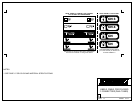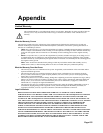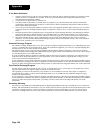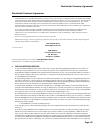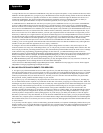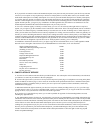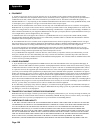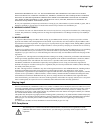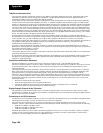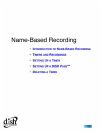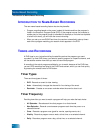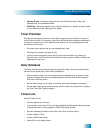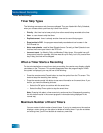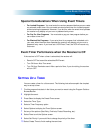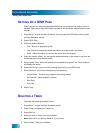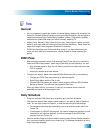
Appendix
Page 160
Telephone Communication
This equipment complies with Part 68 of the FCC rules and the requirements adopted by the ACTA. On the back panel of this
equipment is a label that contains, among other information, a product identifier in the format US:AAAEQ##TXXXX. If
requested, this number must be provided to the telephone company.
A plug and jack used to connect this equipment to the premises wiring and telephone network must comply with the applicable
FCC Part 68 rules and requirements adopted by the ACTA. A compliant telephone cord and modular plug is provided with this
product. It is designed to be connected to a compatible modular jack that is also compliant. See installation instructions for details.
The REN is used to determine the number of devices that may be connected to a telephone line. Excessive RENs on a telephone
line may result in the devices not ringing in response to an incoming call. In most but not all areas, the sum of RENs should not
exceed five (5.0). To be certain of the number of devices that may be connected to a line, as determined by the total RENs, contact
the local telephone company. For products approved after July 23, 2001, the REN for this product is part of the product identifier
that has the format US:AAAEQ##TXXXX. The digits represented by ## are the REN without a decimal point (e.g., 03 is a REN
of 0.3). For earlier products, the REN is separately shown on the label.
If this equipment causes harm to the telephone network, the telephone company will notify you in advance that temporary
discontinuance of service may be required. But if advance notice isn't practical, the telephone company will notify the customer as
soon as possible. Also, you will be advised of your right to file a complaint with the FCC if you believe it is necessary.
The telephone company may make changes in its facilities, equipment, operations or procedures that could affect the operation of
the equipment. If this happens the telephone company will provide advance notice in order for you to make necessary
modifications to maintain uninterrupted service.
If trouble is experienced with this equipment, for repair or warranty information, please contact DISH Network at 1-800-333-
DISH (3474). If the equipment is causing harm to the telephone network, the telephone company may request that you disconnect
the equipment until the problem is resolved.
There are no user serviceable parts inside.
Connection to party line service is subject to state tariffs. Contact the state public utility commission, public service commission or
corporation commission for information.
If your home has specially wired alarm equipment connected to the telephone line, ensure the installation of this equipment does
not disable your alarm equipment. If you have questions about what will disable alarm equipment, consult your telephone
company or a qualified installer.
Compliance Information Statement
EchoStar Technologies Corporation, 94 Inverness Terrace East, Englewood CO., (303) 706-4000, declares that:
This device complies with Part 15 of the FCC Rules. Operation is subject to the following two conditions: (1) this device may not
cause harmful interference, and (2) this device must accept any interference received, including interference that may cause
undesired operation.
This equipment has been tested and found to comply with the limits for a Class B digital device, pursuant to Part 15 of the FCC
Rules. These limits are designed to provide reasonable protection against harmful interference in a residential installation. This
equipment generates, uses and can radiate radio frequency energy and, if not installed and used in accordance with the
instructions, may cause harmful interference to radio communications. However, there is no guarantee that interference will not
occur in a particular installation. If this equipment does cause harmful interference to radio or television reception, which can be
determined by turning the equipment off and on, the user is encouraged to try to correct the interference by one or more of the
following measures:
• Reorient or relocate the receiving antenna.
• Increase the separation between the equipment and receiver.
• Connect the equipment into an outlet on a circuit different from that to which the receiver is connected.
• Consult the dealer or an experienced radio/TV technician for help.
Signal Strength Present at the Television
The attenuator provided with the satellite receiver will limit the signal present at your television set to below the FCC signal
strength limit of 75.6dBuV. If you choose not to install the provided attenuator, you must ensure that the signal strength present at
the TV set does not exceed 75.6dBuV.
Connecting to an Off-Air Antenna
In order to receive local broadcast channels, you may wish to install an off-air antenna into your TV distribution equipment. When
installing the off-air antenna, you must be careful to meet certain FCC regulations.
There are many devices that allow you to connect your antenna to your in-home distribution system such as splitters, and
amplifiers. The FCC requires that the isolation between the antenna port and the network port of your system meet the following:
• 80dB from 54 MHz to 216 MHz, at least
• 60dB from 216 MHz to 550 MHz and at least
• 55dB from 550 MHz to 806 MHz
Measuring the isolation of a device requires specialized equipment. In most cases, it is easier to purchase a splitter or amplifier
with the correctly specified isolation from your local satellite television retailer. The above requirements are extracted from
47CFR15.115. For the complete text please visit WWW.FCC.GOV.



